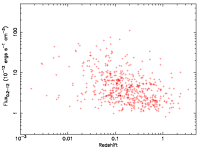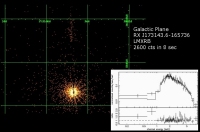XMM-Newton Slew Survey
3 May 2006
For the past 4 years, while XMM-Newton has been moving between targets preparing to perform the next observation, the X-ray astronomy satellite has kept its cameras open and quietly looked at the heavens. This spare-time survey, which comes for free, has now covered an impressive 25% of the sky.Results from an initial processing of the highest quality data (15% of the sky) have been publicly released today and are available through the XMM-Newton Science Archive (XSA) in the form of a catalogue of more than 2700 very bright sources and a further 2000 lower significance sources.
 |
|
Figure 1. Plot in Galactic coordinates of the sources in the XMM-Newton slew survey |
Although the rapid slewing of the satellite across the sky means that a star or galaxy passes through the telescope's field of view in only 10 seconds, the great collecting area of the XMM-Newton mirrors coupled with the efficiency of its CCD cameras, allow thousands of sources to be detected. Furthermore, the position of X-rays from the sky can be pinpointed to within 8 arcseconds, a resolution far superior to most previous all-sky surveys and sufficient to allow the source of these X-rays to be found in many cases. Currently about 55% of the catalogue entries have been identified with known stars, galaxies, quasars and clusters of galaxies.
 |
 |
|
Figure 2. A comparison of the XMM-Newton slew survey vs the ROSAT all-sky survey count rates |
Figure 3. Distribution of Active Galactic Nuclei over redshift and flux (in the 0.2 - 12 keV band) |
Over a decade ago, the ROSAT mission performed an all-sky survey, which can be directly compared with this new catalogue to check the long-term stability of some 2000 objects (figure 2). An initial look shows that some sources have changed their brightness level by a fantastic amount.
The most extreme of these are variable stars and more surprisingly galaxies, whose unusual volatility may be due to large quantities of matter being consumed by an otherwise dormant central black hole.
The slew survey is particularly sensitive to active galactic nuclei (AGN) - galaxies with an unusually bright nucleus - which can be traced out to a distance of 10 billion light years, or a redshift of 3.4 (figure 3).
 |
|
Figure 4. Composite of 81 galaxy clusters known from former sky surveys. Credit: ESA and the XMM-Newton EPIC consortium |
While most X-ray stars and galaxies look like points in the sky, about 15% of the catalogued sources have extended emission. Most of these are clusters of galaxies, gigantic conglomerations of galaxies which trap hot, X-ray emitting gas, over scales of a million light years. Eighty-one of these are already famous from earlier work but many previously unknown galaxy clusters are present in the catalogue. It is hoped that these will include high luminosity, very distant clusters which are invaluable for investigating the evolution of the Universe. Follow-up observations, using large optical telescopes are now needed to determine the distances of the individual galaxies in the newly discovered clusters.
Using traditional pointed observations, it takes huge amounts of telescope time, to image very large sky features, such as old supernova remnants (SNR), in their entirety. The slewing mechanism provides a very efficient method of mapping these objects and several have been imaged including the 20 000 year old Vela SNR which occupies an area on the sky that is 150 times larger than the full Moon (figure 5).
Extraordinarily bright, low-mass X-ray binaries (LMXB), which are powered by matter pulled from a normal star, exploding onto the surface of a neutron star or being consumed by a black hole, are observed with sufficient sensitivity to record a detailed spectrum (figure 6, inset). Passes across these mega-X-ray sources, can help astronomers understand the long-term physics of the interaction between the two stars of the binary system.
Many areas of astronomy are expected to be influenced by this work and it is planned to continually update the catalogue as XMM-Newton charts its way through the stars. Given the actual operation mode, XMM-Newton slews over about 15% of the sky per year, accumulating a tremendous legacy for the future.
A faster turn-around of slew data processing is now planned to catch interesting transient targets in the act, before they have a chance to fade. This will give access to rare, energetic events, which only a sensitive wide-angle survey such as this can achieve.
Contact
Matteo Guainazzi
ESA XMM-Newton Science Operations
E-mail: matteo.guainazzi sciops.esa.int
sciops.esa.int
Richard Saxton
ESA XMM-Newton Science Operations
E-mail: richard.saxton sciops.esa.int
sciops.esa.int
Norbert Schartel
ESA XMM-Newton Project Scientist
E-mail: norbert.schartel sciops.esa.int
sciops.esa.int



